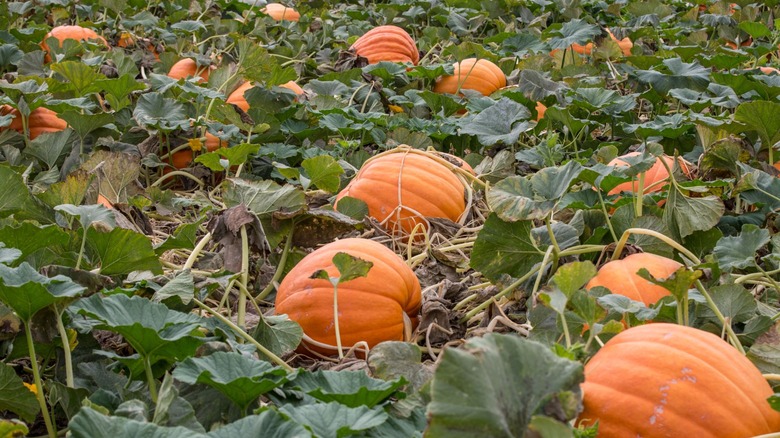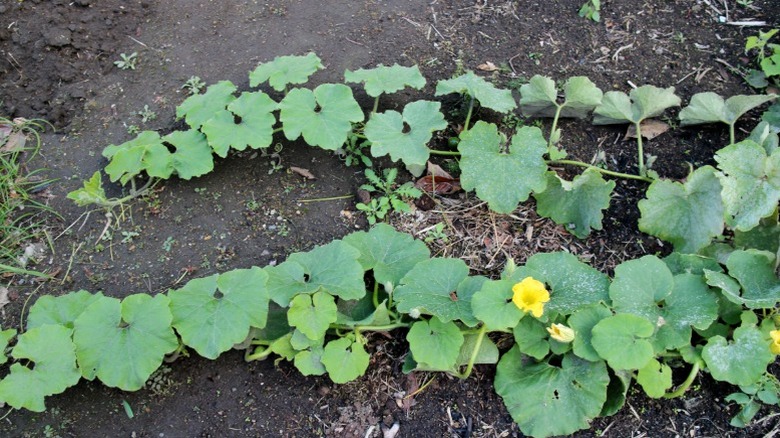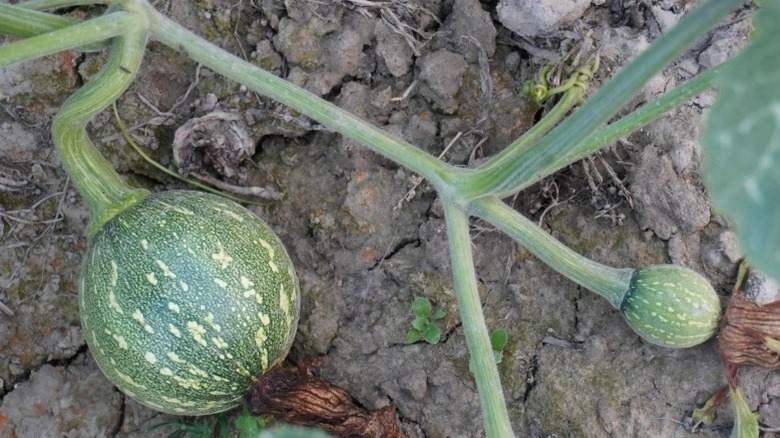The Very Best Way To Prune Pumpkin Plant Vines
Martha Stewart's expert advice for growing perfect pumpkins suggests you plant them at the perimeter of your garden. This placement might be a good way to manage the long, twisting vines of many varieties of pumpkins (Cucurbita spp.) so they don't encroach on other plants. However, while giving your pumpkins adequate space in the garden is necessary, don't neglect one major maintenance task that can help control their growth. Pruning unruly pumpkin vines can ensure the best harvest. In general, the best way to prune a plant is to remove unnecessary vines that do not help bring water or nutrients to your growing pumpkins. Your main goal should be to help the plant push more of its energy towards growing fruit on the main vine.
Vining varieties of pumpkins need the most space. Allot at least 50 to 100 square feet of room per plant and up to 8 feet to spread. When it comes to pruning these sprawling plants, categorize the vines as primary, secondary, or tertiary. Start by pinpointing the primary, or main, vine of each pumpkin plant. From there you can identify the secondary and tertiary vines. In general, thin tertiary vines need to be removed completely. Secondary vines, however, have a big role in bringing nutrients to the fruits and securing the plant during windy weather. For secondary vines, cut or trim only as needed to ensure that they do not hinder the main vine's growth.
How to identify primary, secondary, and tertiary vines
Before you can successfully prune a pumpkin plant, you need to know the difference in the types of vines. Primary vines typically grow from the start of the plant, directly on the hill where you planted your seeds. Pumpkin plants will have at least one main vine which develops fruit, if not several.
If you follow the main vine along the ground as it grows, you will notice other vines branching off of it. These vines are called secondary vines or runners. Secondary vines support the growth of the entire plant as anchors to the main vines. A pumpkin plant's tertiary vines develop last. These thinner vines branch off of secondary vines. Unlike secondary vines, however, they do not benefit the overall health of the plant and can be fully removed where they develop at the secondary vine.
Before pruning your pumpkin plants, determine if it's the right time. You need to give your plants enough time to start growing and establishing themselves before hacking off vines. Wait until primary vines run 10 to 15 feet past the last growing pumpkin before pruning. For secondary vines, wait until they are about 10 feet out from the main vine.
Pruning tips to grow the best pumpkins
Remember that when it comes to pumpkin plant pruning, the process of pruning itself is easiest – just snip the vine with a clean pair of garden shears. For secondary and primary vines, cut off just the tip rather than the entire vine like you should with a tertiary one. To improve the health of your plant, you can bury the ends of vines after you snip them. The vines will develop shallow roots which can help bring water to your pumpkins. Pruning pumpkin plants also makes them easier to manage and goes hand in hand with removing weeds around your vines, a neglected gardening task that may be seriously hurting pumpkin crops.
These methods for pruning pumpkins can be used for all species, including giant varieties. A major tip to grow massive and fair-worthy pumpkins is to pay attention to pruning. By removing most of the tertiary vines, you can concentrate more energy towards one pumpkin plant per each plant. In this extreme version of pumpkin pruning, you absolutely want to turn all of the plant's energy towards growing and sustaining one, solitary fruit. To pick one fruit, pinpoint the fastest-growing one to put all your attention on. For most gardeners, however, their pruning will be limited to maintaining healthy pumpkin plants and training them to grow in a specific space.


